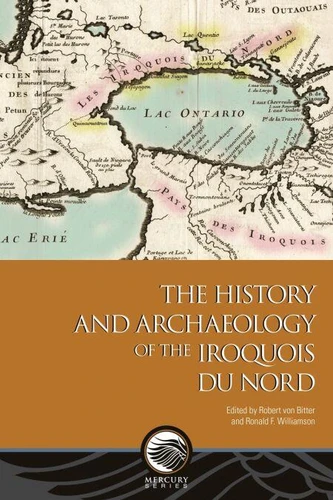The History and Archaeology of the Iroquois du Nord
Par : , , , ,Formats :
Disponible dans votre compte client Decitre ou Furet du Nord dès validation de votre commande. Le format PDF protégé est :
- Compatible avec une lecture sur My Vivlio (smartphone, tablette, ordinateur)
- Compatible avec une lecture sur liseuses Vivlio
- Pour les liseuses autres que Vivlio, vous devez utiliser le logiciel Adobe Digital Edition. Non compatible avec la lecture sur les liseuses Kindle, Remarkable et Sony
- Non compatible avec un achat hors France métropolitaine
 , qui est-ce ?
, qui est-ce ?Notre partenaire de plateforme de lecture numérique où vous retrouverez l'ensemble de vos ebooks gratuitement
Pour en savoir plus sur nos ebooks, consultez notre aide en ligne ici
- Nombre de pages384
- FormatPDF
- ISBN978-0-7766-3982-6
- EAN9780776639826
- Date de parution21/03/2023
- Protection num.Adobe DRM
- Taille25 Mo
- Infos supplémentairespdf
- ÉditeurMercury-Mercure
Résumé
In the mid-to late 1660s and early 1670s, the Haudenosaunee established a series of settlements at strategic locations along the trade routes inland at short distances from the north shore of Lake Ontario. From east to west, these communities consisted of Ganneious, on Napanee or Hay Bay, on the Bay of Quinte; Kenté, near the isthmus of the Quinte Peninsula; Ganaraské, at the mouth of the Ganaraska River; Quintio, on Rice Lake; Ganatsekwyagon, near the mouth of the Rouge River; Teiaiagon, near the mouth of the Humber River; and Qutinaouatoua, inland from the western end of Lake Ontario.
All of these settlements likely contained people from several Haudenosaunee nations as well as former Ontario Iroquoians who had been adopted by the Haudenosaunee. These self-sufficient places acted as bases for their own inhabitants but also served as stopovers for south shore Haudenosaunee on their way to and from the beaver hunt beyond the lower Great Lakes. The Cayuga village of Kenté was where, in 1668, the Sulpicians established a mission by the same name, which became the basis for the region's later name of Quinte.
In 1676, a short-lived subsidiary mission was established at Teiaiagon. It appears that most of the north shore villages were abandoned by 1688. This volume brings together traditional Indigenous knowledge as well as documentary and recent archaeological evidence of this period and focuses on describing the historical context and efforts to find the settlements and presents examinations of the unique material culture found at them and at similar communities in the Haudenosaunee homeland.
Available formats: trade paperback and accessible PDF
All of these settlements likely contained people from several Haudenosaunee nations as well as former Ontario Iroquoians who had been adopted by the Haudenosaunee. These self-sufficient places acted as bases for their own inhabitants but also served as stopovers for south shore Haudenosaunee on their way to and from the beaver hunt beyond the lower Great Lakes. The Cayuga village of Kenté was where, in 1668, the Sulpicians established a mission by the same name, which became the basis for the region's later name of Quinte.
In 1676, a short-lived subsidiary mission was established at Teiaiagon. It appears that most of the north shore villages were abandoned by 1688. This volume brings together traditional Indigenous knowledge as well as documentary and recent archaeological evidence of this period and focuses on describing the historical context and efforts to find the settlements and presents examinations of the unique material culture found at them and at similar communities in the Haudenosaunee homeland.
Available formats: trade paperback and accessible PDF
In the mid-to late 1660s and early 1670s, the Haudenosaunee established a series of settlements at strategic locations along the trade routes inland at short distances from the north shore of Lake Ontario. From east to west, these communities consisted of Ganneious, on Napanee or Hay Bay, on the Bay of Quinte; Kenté, near the isthmus of the Quinte Peninsula; Ganaraské, at the mouth of the Ganaraska River; Quintio, on Rice Lake; Ganatsekwyagon, near the mouth of the Rouge River; Teiaiagon, near the mouth of the Humber River; and Qutinaouatoua, inland from the western end of Lake Ontario.
All of these settlements likely contained people from several Haudenosaunee nations as well as former Ontario Iroquoians who had been adopted by the Haudenosaunee. These self-sufficient places acted as bases for their own inhabitants but also served as stopovers for south shore Haudenosaunee on their way to and from the beaver hunt beyond the lower Great Lakes. The Cayuga village of Kenté was where, in 1668, the Sulpicians established a mission by the same name, which became the basis for the region's later name of Quinte.
In 1676, a short-lived subsidiary mission was established at Teiaiagon. It appears that most of the north shore villages were abandoned by 1688. This volume brings together traditional Indigenous knowledge as well as documentary and recent archaeological evidence of this period and focuses on describing the historical context and efforts to find the settlements and presents examinations of the unique material culture found at them and at similar communities in the Haudenosaunee homeland.
Available formats: trade paperback and accessible PDF
All of these settlements likely contained people from several Haudenosaunee nations as well as former Ontario Iroquoians who had been adopted by the Haudenosaunee. These self-sufficient places acted as bases for their own inhabitants but also served as stopovers for south shore Haudenosaunee on their way to and from the beaver hunt beyond the lower Great Lakes. The Cayuga village of Kenté was where, in 1668, the Sulpicians established a mission by the same name, which became the basis for the region's later name of Quinte.
In 1676, a short-lived subsidiary mission was established at Teiaiagon. It appears that most of the north shore villages were abandoned by 1688. This volume brings together traditional Indigenous knowledge as well as documentary and recent archaeological evidence of this period and focuses on describing the historical context and efforts to find the settlements and presents examinations of the unique material culture found at them and at similar communities in the Haudenosaunee homeland.
Available formats: trade paperback and accessible PDF




